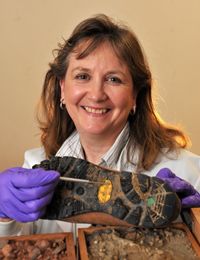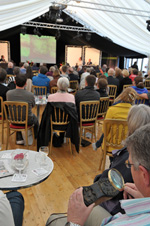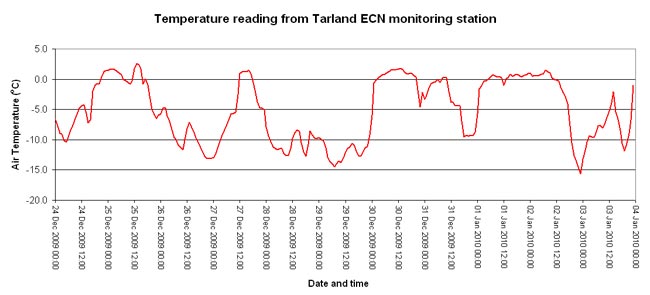What's new...
January 2010
'What's new' items from:
Institute Scientist Advises TV Forensics Drama
21 January 2010
"I have a colleague who has expertise in soil forensics, did a PhD on the mineral characterisation of soils. We could do an elemental analysis and compare to the available soil and geochemistry databases...." says Dr Nikki Alexander (Emilia Fox) in tonight's (Thursday 21st January 2010) edition of the BBC's Silent Witness.
 The colleague she is referring to is Dr Lorna Dawson (pictured). As head of the Soil Forensics Group at the Macaulay Land Use Research Institute in Aberdeen, Lorna’s research into plant and soil interaction spanning more than 20 years has taken her from rural locations to courtrooms and more recently, behind the scenes of a television drama.
The colleague she is referring to is Dr Lorna Dawson (pictured). As head of the Soil Forensics Group at the Macaulay Land Use Research Institute in Aberdeen, Lorna’s research into plant and soil interaction spanning more than 20 years has taken her from rural locations to courtrooms and more recently, behind the scenes of a television drama.
Lorna was involved in the new series of Silent Witness, the BBC hit drama featuring forensic experts who investigate crimes and murders. With her extensive experience in soil forensics, Lorna was required as an advisor for the filming of a new episode, which is due to be aired tonight. She provided advice to the programme’s writers about site selection and soil forensic analysis.
Lorna says, “I was sworn to secrecy about the details of the episode, but I could say that it involved a murder story in an outdoor setting and the use of soil forensic analysis. I really enjoyed working on this story; it’s great to see programmes like Silent Witness making the use of forensic science more accessible to the public.”
As well as helping television’s fictional characters to fulfil their roles, Lorna also assists in the solving of real-life crimes through her work with the police and the criminal justice system. In recent years the application of soil forensics to criminal cases has become more frequent, leading to its use in high profile cases such as the Sarah Payne and Soham murders. By using the unique signatures of natural minerals, organic, and synthetic components found in the soil, experts can help locate the graves of murder victims or link a suspect with a crime scene by examining dirt found on clothing, footwear and even in the tread of a vehicle’s tyre.
Lorna explains, “Every patch of soil has its own ‘fingerprint’ which means that we can help identify the location that it came from. Analysing the soil is carried out in three different parts. Firstly, the inorganic part that is derived from the rock underneath the soil provides the mineral signature, and links to the underlying geological map unit. Secondly, any vegetation that has grown in that soil provides the organic signature linking to the plant composition, and thirdly, the living organisms that inhabit the soil provide its DNA.”
In addition to her police work and making science more accessible, Lorna is currently working on a two year project to compile a database that holds the signature values for every type of soil and vegetation type in Scotland. Once completed, the database will serve as a reference source for criminal investigations as well as policy makers wishing to determine areas of soil that are most susceptible to climate change. The records will also benefit other scientific researchers and farmers who want to make more efficient use of fertilisers for crop growth.
Lorna says, “Soil feeds into the rest of our environment and is an incredibly important material, not just in terms of its scientific uses, but also for our health, through filtering the air that we breathe and providing the food that we eat. The work that we do at the Macaulay Land Use Research Institute is helping to raise the profile of soil and the potential uses of soil signatures across the UK, and subsequently increasing its application in areas such as criminal and environmental investigations and the agriculture industry.”
Watch Thursday's episode of Silent Witness on BBC i-player (available until 28th January 2010).
Part 2 of this episode, which aired on Friday 22nd January, is also available to view on BBC i-player (until 29th January 2010).
Murder, Mystery & Microscopes in Running for the Best Live Communications Event in Scotland
15 January 2010

Murder, Mystery & Microscopes has made the final shortlist for the Best Live Communications Event in the British Association of Communicators in Business (CiB) Scotland Awards 2009.
Judged by a panel of respected and leading industry figures, the prestigious awards take place at a black tie event on February 26th in Glasgow where category award winners will be announced.
A collaborative initiative between the Macaulay Land Use Research Institute and Aberdeen's two universities, offers the opportunity for people to learn about the real scientific basis for criminal investigations, from practicing scientists, in an informative and entertaining way by bringing together popular author readings and scientist responses to explore both the myths and realities of science and crime fiction.
The CiB Awards Scotland recognise the very best communications produced in Scotland. They celebrate the talent, skills and achievements of communication professionals and offer an opportunity for organisations to share the work they are proud of and be commended for their achievements and contribution and to business and society. The Institute will be competing alongside some of the UK's top names in business communication. Other prominent organisations also shortlisted for awards over a total of 35 categories include BSkyB, TOTAL, The Royal Bank of Scotland, Historic Scotland and the NHS.
Professor David Miller from the Macaulay Land Use Research Institute who helps co-ordinate the Murder, Mystery & Microscope events said, "It’s an honour to have made it onto the shortlist of the CiB Scotland Awards 2009. To receive recognition for all the hard work that goes in to each event is extremely rewarding. We look forward to what promises to be an enjoyable, and hopefully a very successful, evening."
More information on Murder, Mystery & Microscopes is available at macaulay.ac.uk/mmm.
Institute's monitoring stations capture freezing conditions
7 January 2010
The current freezing weather conditions in Scotland have been vividly captured by the Institute's environmental monitoring sites. The graph below shows the air temperature recorded from the river monitoring site at Tarland over the Christmas and New Year period with temperatures dipping down to -15°C. The plummet from around 0°C to around -15°C in during the evening of 2nd January is particularly dramatic.
Further information on the 'real time' data captured at the Institute's other monitoring sites is available at: www.macaulay.ac.uk/ECN

You can find more stories about the Macaulay Land Use Research Institute in the latest edition of our newsletter, in-land.
News about upcoming events can be found here.
Media releases can be found here.
|
Updated: 23 Jan 2024, Content by: CN
|



